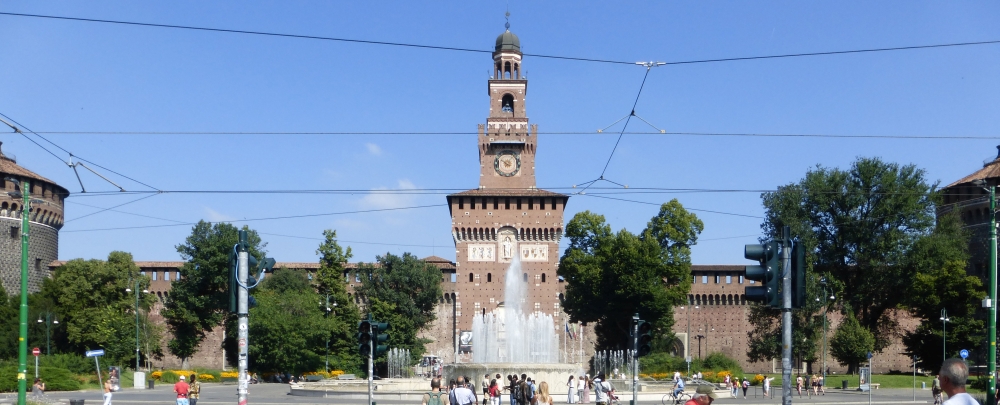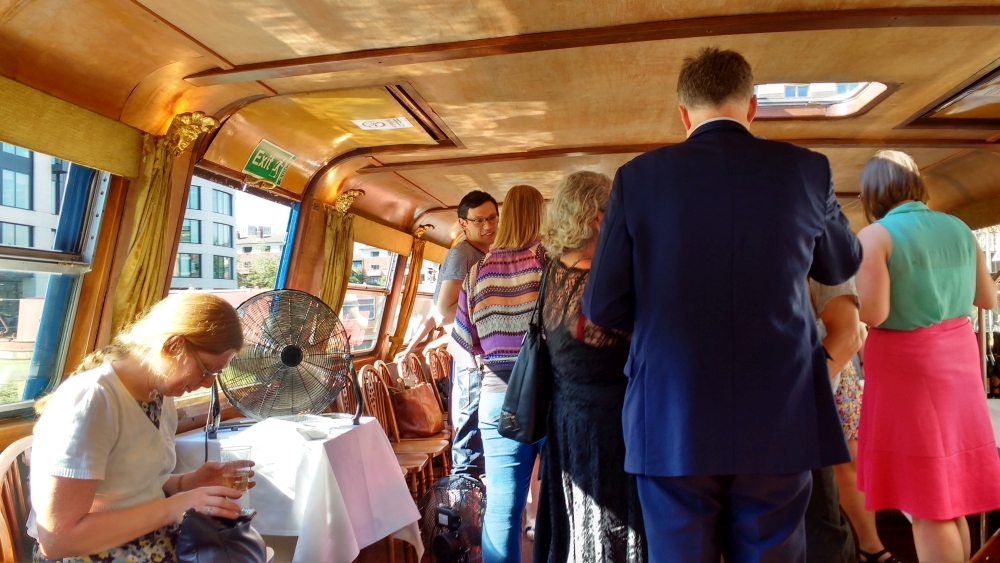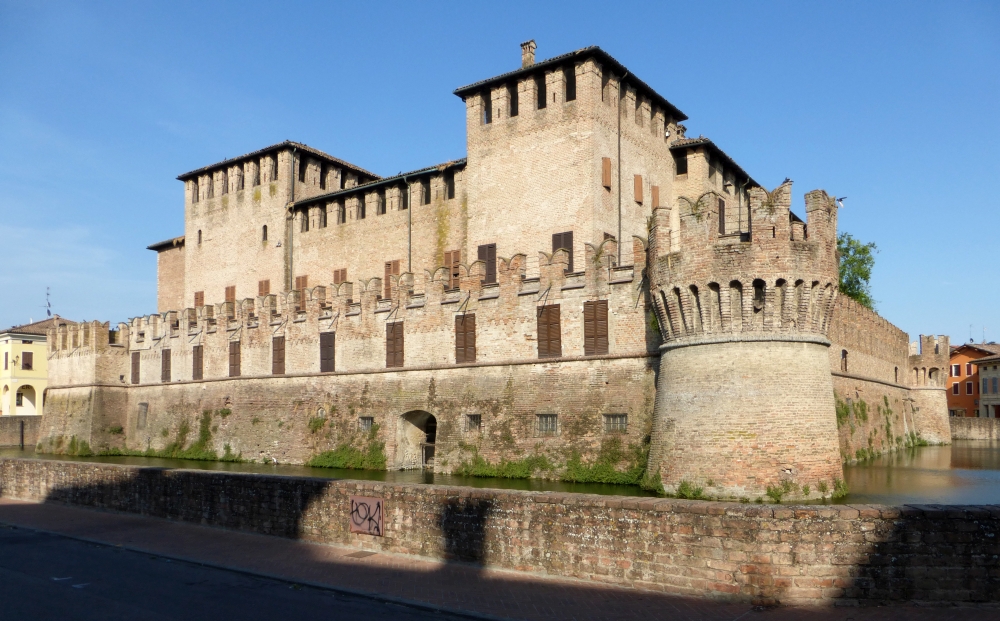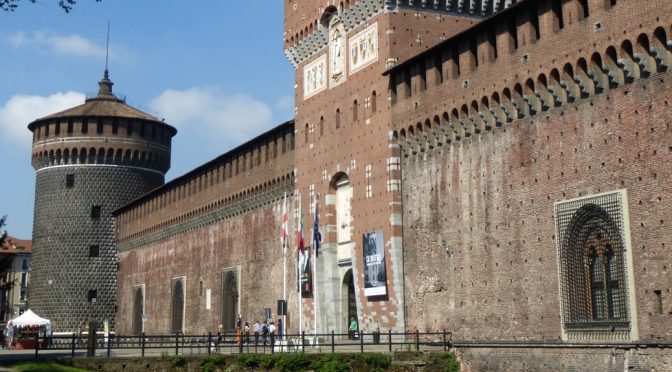July was a busy month – so busy, that I’ve only now finished writing up notes from the five different conferences, workshops and meetings that I attended in just over three weeks. But why spend so much time out of the office?
CIDOC
The first – and longest – meeting was the annual conference of CIDOC, the Comité International pour la Documentation of ICOM, the International Council of Museums, held this year as part of ICOM’s triennial conference in Milan from 4 to 8 July. Some of you may remember that I went to the CIDOC conference in Dresden a couple of years ago, and the reasons for going then still hold good: meeting my colleagues from other institutions, finding out what they’re doing, and comparing experiences. This time, though, I also gave a brief paper,1 co-authored with Angela Kipp of the Technoseum in Mannheim, about raising the profile of documentation. (And Angela has published her thoughts on the conference, too.2 )
As always, one leaves a conference with a mass of different things to take away and mull over. CIDOC being what it is, some of these were about standards: Emmanuelle Delmas-Glass provided a quick introduction [25 MB PowerPoint document] to the International Image Interoperability Framework, IIIF, rapidly emerging as a standard protocol for sophisticated querying of image databases. Mike Jones gave a paper which said, much more succinctly than I could, how much of the meaning in museum and archive catalogues lies in the connections between entities and why it’s therefore important to expose them. And, in an off-site day of workshops in Turin, Jonathan Whitson Cloud ran through a series of definitions of museum documentation before suggesting his own, pragmatic (and polite) one:
Documentation is recording museum information that might be worth retrieving in such a manner that it can be retrieved and that it is worth retrieving … and being nice to people.
It was also an opportunity to meet colleagues, notably Angela, for whose Registrar Trek blog I wrote an article some years ago and with I whom I delivered my paper at this conference, but whom I only met for the first time the day before we spoke. I spent some time quizzing Emmanuelle Delmas-Glass about the Yale Center for British Art‘s experiences using the TMS collections management system to serve Linked Open Data, as this is something we will be trying to do at the National Gallery over the next couple of years.
Indeed, one of the things that emerged from the conference was the availability, either right now in the near future, of tools which exploit the possibilities of semantically-enabled museum data to provide rich research environments, notably WissKI (presented by Siegfried Krause [10 MB PowerPoint document]) and ResearchSpace (presented by Dominic Oldman [4 MB PDF]). And there are an increasing number of linked open heritage datasets out there – one that has sparked my interest is the Fondazione Federico Zeri’s, which includes information relating to National Gallery paintings.

But the conference was not just made up of formal papers: Nicholas Crofts ran a very useful workshop on ‘How to capitalize on museum documentation?’, which provided a series of practical methods for prioritising resources for digitisation, sharing, and crowdsourcing. At the Turin off-site day, I joined a group discussing the potential of visualisation for presenting data to audiences; we were particularly struck by the potential of well-conceived visualisations for showing people the answers to questions they didn’t know they needed to ask.
Of course, it wouldn’t be a good conference if one didn’t leave worried about something: in my case, the approaching tsunami that is digital preservation, discussed in a session focusing on UNESCO’s PERSIST preservation guidelines. And I’m becoming increasingly unsure of the capabilities of current collections management systems to actually meet all the needs that ambitious museums have of them: not just to catalogue the objects, but to control and administer the procedures with which we manage the collections – and also to provide researchers with rich, complex data about the collections in standardised, interoperable formats.
It was also good to catch up with former colleagues. Because many of the other ICOM international committees were meeting in the broader framework of the ICOM conference, I heard Mimi Waitzman, the Horniman Museum‘s Deputy Keeper of Musical Instruments, speak about the creative programming she had been running using the Horniman’s Kirckman harpsichord at the museum’s main site (whilst I was buried in the stores) – and announce the success of a major bid to purchase several instruments in playing condition following the closure of Finchcock’s Musical Museum, and run an extensive engagement project using them. I also had a chance to chat with my successor at the Horniman, Jonathan Whitson Cloud: I’m delighted to be leaving the museum’s documentation in such capable hands.
And of course there were the plenary lectures provided by the broader conference: the highlight for me was a crash-course in the economics of museums by David Throsby:
Others would have been struck by Christo‘s look back at the projects he and Jeanne-Claude had carried out over the past decades, culminating in their floating piers at Lake Iseo; or the discussion of museums as agents for social change.
And needless to say, there were some memorable parties. (If this has whetted your appetite, then next year’s CIDOC conference [3 MB PDF] will be taking place in Tbilisi from 25 to 29 September 2017.)
TMS User Group
But I had to leave Milan before the grand closing party of the ICOM conference in order to turn myself around and get up to Leeds Discovery Centre for a two-day training session and meeting for UK-based users of TMS, the collections management system developed by Gallery Systems that we use at the National Gallery.
The first day, 11 July, was spent on a run through of the basics of system administration: an extensive subject because, like most similar systems, a great deal of what the user sees in TMS can be changed by the system’s administrator. At the National Gallery, that’s me, and, if you follow me on Twitter, you’ll have seen my gradual progress through the help files (there’s no manual as such) earlier this year, whilst I taught myself how the system works from scratch. This is the third such system, after MuseumPlus (used at the Ashmolean Museum) and Mimsy (used at the Horniman) that I’ve had to learn, so I’m beginning to get the hang of how they work more generally, and what things it’s most important that I know first.
The second day was a more typical user group meeting. These kinds of event are held by most suppliers of collections management software, usually every six months to a year, for users in a particular country or territory. They generally take the same basic shape.
Individual sites will report on what they’ve been doing with the system (or to it) since the last meeting: this is a useful way of seeing if anyone else has done anything similar, or is planning it, and comparing notes and sharing advice, as well as often providing a stimulus to develop the system at one’s own museum. So we heard from Leeds Museums and Galleries, Sheffield Industrial Museums Trust, and the Henry Moore Foundation, whilst I gave a presentation on plans at the National Gallery for a radical overhaul and improvement of our digital provision of collection information.
There are also usually one or more more formal presentations about specific projects related to the system in question, or related subjects. In Leeds, Dieter Van Hassel of the Koninklijk Museum voor Midden-Afrika / Musée royal de l’Afrique centrale in Tervuren told us about IIIF (is a theme emerging?), and Madeline Betts spoke about Tate‘s new systems for managing collections management jobs usingTMS.
And finally, these meetings are usually attended by the software’s developers, in this case Gallery Systems: they provide an opportunity for users to speak directly to the vendors (it can be more persuasive if a whole group of users are all saying the same thing, loudly), and the vendors take the opportunity to introduce new versions and features to the users, and sometime to canvass opinion about the direction they should follow as they develop the system. This time, Gallery Systems presented the revised back-end architecture for the 2014 and 2016 versions of TMS, and how they relate to the future development of the system; and they showed us the new features in release 2 of TMS 2016.
I usually try and go to the user group meetings for whichever piece of software I’m working with whenever I can: it’s always good to meet your colleagues in other organisations who are dealing with the same issues as you are (and can help when you run into something unexpected), and I think it’s also helpful to know your vendor’s representatives personally, and build up a relationship with them. After all, as I said when I was speaking about the Horniman’s recent collections review project:
The developer of your collections management system is your friend: they may well be able to help you with tools and tweaks which will make your life much easier.
UKRG
A week later, on 18July, I was making my way to the Canal Museum in King’s Cross for one of the regular meetings organised by the UK Registrars’ Group, UKRG. For those of you who don’t know – and there do seem to be people who don’t:
Extract from an email that had an office of registrars seething today! Fury we can relate to #whataretheregistrars pic.twitter.com/c12ZcvDv7B
— UK Registrars Group (@UKregistrars) September 2, 2016
Registrars in museums can have any number of duties related to the administrative care of the objects. Although the registrars’ responsibilities can vary hugely from museum to museum, and the people doing the work may not even be called registrars, they usually arrange all the details of loans into and out of the museum, and in many organisations are also responsible for acquisitions, deaccessions and disposals, and related matters; in some cases, they also deal with day-to-day object movements. In short, much of what they do is closely related to museum documentation [450 kB PDF] and many of the procedures which the latter aims to manage. The UKRG is the organisation for museum registrars in the UK, set up by and run by the registrars themselves – so I try and get to their meetings (which are usually free) whenever I can.
July’s meeting, entitled The things you never knew you never knew …, was more of a mixed bag than usual (meetings are usually themed), but no less fascinating for that. Katie Childs from the National Museum Directors’ Council gave an overview of current changes in museum policy – including a first glimpse at what Brexit might mean for museums, within four weeks of the result of the referendum; Kathy Richmond spoke about the challenges of organising an exhibition which involved objects connected to real and very serious crimes at the Museum of London; Hetty Gleave of Hunters and the Institute of Art & Law outlined the legal position of human remains (I think the one fact that most people will have taken away from the meeting was that a corpse cannot legally be owned); Simon Carter spoke about managing the collections at St Paul’s Cathedral; and Robert Graham of Blackwall Green ran through changes that are emerging in the insurance market for works of art.
One of the nice things about the UKRG is that most of its members deal regularly with the major art handling and shipping companies – who are therefore often keen to support the UKRG’s meetings, which means in turn that the events often end with a good party. In July’s case, this was a trip on a canal boat from King’s Cross to Camden Lock, with prosecco served along the way: a great end to the day, spent chatting to current and former colleagues in a more relaxed atmosphere than usual.

(The next UKRG event, focussing on loans, along with the Annual General Meeting, will be on Friday 7 October at Dulwich Picture Gallery – but it’s already fully booked.)
Museum Documentation Network
The Thursday after the UKRG meeting saw me at the British Museum for a meeting of the Museum Documentation Network. This is a small, informal group which was set up a few years ago for documentation managers (or the senior people charged with documentation) in London national and major partner museums. The meetings last half a day, and mostly consist of a round-the-table briefing on what each institution has been doing or is planning with its documentation; sometimes somebody also gives a more formal presentation, although the discussion will often focus in on particular problems or issues which have emerged during the round-table.
In July, representatives of the British Film Institute, British Museum, Crafts Council, Horniman Museum, London Transport Museum, Sir John Soane’s Museum, Victoria & Albert Museum, and Wallace Collection all spoke about recent documentation developments at their institutions; I summarised progress and plans at the National Gallery. Julia Stribblehill of the BM also introduced their workflows for the bulk identification of objects’ copyright statuses – no mean task when your collection numbers several million items. We also discussed the terminology to use when describing born-digital artefacts, something that’s exercising the BFI, in particular, at the moment.
Again, it’s very useful to see what other institutions are doing, not just with their computer systems, but with documentation more generally. The group also provides a mutual support network for documentation managers; there are, after all, not very many of us (one per major museum if we’re lucky), and it’s good to receive the occasional reassurance from one’s peers that one really is on the right track. It’s also nice to keep up with some of the colleagues who I used to see at Mimsy user groups which, as the National Gallery uses TMS as its collections management system, I no longer attend.
CIIM User Group
And last, on 27 July, there was another user group meeting, for a piece of software which I had installed at the Horniman Museum: the Collection Information Integration Manager (usually called the CIIM, pronounced ‘sim’), developed by Knowledge Integration (a.k.a. K-Int). In simple terms, this takes data and files automatically from one or more sources, usually including a museum’s collections management system, and stores them in an intermediate database; allows users to edit and organise them into groups and stories without altering the original data; and exposes the information to consuming applications in a number of different formats and metadata standards via a number of different endpoints.3 It also allows users to manage the extraction and publication of data, and has other modules to handle things like user-generated content. The upshot is that the CIIM makes the process of writing information about museum objects once, extracting it, and publishing it through multiple channels, relatively painless.
Although we don’t run this at the National Gallery, no-one stepped up to replace me as coordinator of the user group when I left the Horniman, and so I continue to chair the meetings for the time being. They happen every six months, and this time we were the guests of the Imperial War Museum in London. They usually last for a long afternoon – we start a little before lunch, and run on until the end of the day (when we often adjourn to the pub). We had reports from Agueddfa Cymru – National Museum Wales and the Science Museum Group, who are both currently introducing the CIIM; and the Fitzwilliam Museum, Horniman Museum, Imperial War Museums, Manx National Heritage, and Museum of London who are amongst the institutions which already run it. Some are simply keeping the system ticking over as a feed for in-gallery interactives, websites, and so on; others – usually organisations who have developers that they can call on amongst their staff – are continuing to work hard to develop the systems that feed into their CIIM, and that draw from it. Knowledge Integration are currently rolling out a new version of the software, so it’s also an opportunity to compare notes about the work required to upgrade, and how smooth the process is; and as with other groups, it’s always useful to hear what other people are doing and see how it relates to one’s own experiences – or plans.
Another significant part of these meetings takes place at the very beginning, when the users meet without Knowledge Integration in the room. The aim is for them to raise any problems they’re having with K-Int, which are then collated and fed back to the latter later in the day. This is a really valuable opportunity for the users to exercise their muscle and, together, emphasise problems that, if reported one by one by individual sites, might not have received the attention they deserve – and Knowledge Integration, who have recently been working hard on a number of major projects, would, I think, be the first to admit that this part of the meeting helps them improve the ways they relate to their clients.
In the final part of the meeting, Knowledge Integration tell the users what has been happening within the company, and what developments have taken place recently within the software, or are planned for the future. In July, or example, we heard about their work on the Archives Hub; tools developed to help automate the linking within the system of different resources which are indexed using object accession numbers, when those numbers have not been entered consistently; the CIIM’s new ability to synthesise a unique and persistent URI when it’s fed two different authority records for a single entity; and its RESTful API for interfaces to the CIIM. Again, this is how users keep track of tools and developments that they might wish to exploit in the future.
Time out of the office

So, why have I spent so much time out of the office? Partly because it exposed me to the wider picture, both of what’s happening in my immediate field and the tools which I use, and of broader, more abstract and theoretical questions. But also in order to meet my colleagues – local, national, and international – and compare notes, achievements, and frustrations: we have much in common and, contrary to all those stereotypes, museum documentation can be a very sociable activity.
Update
6 October 2016: reference to Angela Kipp’s account of the conference added in second paragraph. (And see now – 31 October 2016 – her further thoughts.)
Notes
- Also available in German. [↩]
- Also available in German and Polish [300 kB PDF]. [↩]
- If you’re feeling brave, these include: XML or JSON via a Solr or Elasticsearch API, XML via an OAI-PMH server, Linked Data via a SPARQL endpoint, and so on. [↩]

